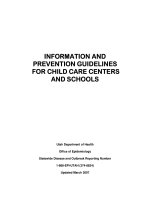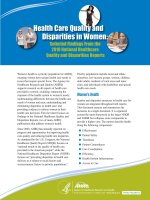Care labeling and consumers
Bạn đang xem bản rút gọn của tài liệu. Xem và tải ngay bản đầy đủ của tài liệu tại đây (51.49 KB, 16 trang )
Care Labeling and Consumers
Nancy L. Cassill
University of North Carolina at Greensboro
Dr. Cassill is Associate Professor of Textile Products Marketing in the Department of
Clothing and Textiles at the University of North Carolina at Greensboro (UNCG).
At UNCG, Dr. Cassill teaches courses in merchandising, retailing, textile products
marketing, textile products consumer behavior, and international sourcing. She
serves as President-elect for the International Textile and Apparel Association
and is a member of the International Fabricare Institute Technical Advisory
Board. Dr. Cassill holds degrees from Purdue University, Indiana University, and the
University of Tennessee-Knoxville.
T
oday’s consumer wants apparel that is easy to
care for, comfortable, and priced affordably to fit
their budget and lifestyle. These apparel preferences have challenges for fiber producers, fabric mills,
apparel manufacturers, retailers, and fabric care
specialists.
Today’s Consumer—
Educated and Demanding
Today’s consumer is educated and demanding. The
consumer has two thoughts: “save me energy” and
“save me stress.” Save me energy translates into the
following apparel preferences:
●
Make it simple to buy apparel
●
Make it simple to care for apparel
●
Make it simple to understand and to wear apparel
Save me stress means:
●
Reduce problems
●
Guarantee fair prices
●
Offer a simple return policy
Today’s consumer also has attitudes about “casual
workplace apparel” and new apparel products. The
casual workplace (also known as dressing down) has
been in the U.S. corporate environment since 1979. In
the past 3 years, there has been an increase in wearing
casual wear to work. This increase has been evident
by: the growing number of companies that have insti-
tuted casual day, and the increased number of casual
days for companies.
In 1996, casual apparel for the workplace translates
as “casual and comfortable” apparel. Recent research
examining the casual workplace with U.S. Fortune 500
companies has found that the casual workplace has not
peaked. There has been a rapid acceleration of Fortune
500 companies adopting this practice within the last 2
years (1994-96) and the number of companies instituting the casual workplace continues to increase. Casual
apparel has become part of the corporate culture.
Research has found that casual apparel improves
workplace morale and is a no cost benefit to companies. No wonder over two-thirds of all U.S. companies
have established some form of casual dress for the
workplace.
New apparel products are the life of the textile and
apparel industry. Today’s consumer is searching for
new, exciting and different apparel products.
However, one remembers the distressing apparel retail
environment in 1995 and 1996, when consumers opted
to purchase hard goods, such as computers, instead of
soft goods, such as apparel products. Lack of product
innovation, purchasing computers instead of apparel,
and consumers viewing apparel product sameness, has
caused consumers to push the limits on life expectancy
of apparel (a real challenge for fabric care specialists).
Consumer attitudes about shopping are interesting.
In 1996, traditional shopping is less leisure driven and
more of a chore. The retail marketplace presents pricing games. Time and energy constraints, lack of convenience (consumer may be less brand and less store
loyal), and less interest in shopping are three reasons
why some consumers are shopping less than 1 hour a
week.
185
Apparel Care and the Environment
Consumer Attitudes About
Care Labels
Many educated consumers are label conscious. For
these consumers, care is an important criterion. Care
labels become increasing important with the in-store
wrinkle resistant merchandising that emerged in the
early 1990’s. In addition, consumers still look at brand
labels, fiber content, and now closely examine country
of origin labels since child labor issues have come to
light.
However, consumers are not educated about the difference between dry cleaning and laundry services.
Specifically, consumers are not educated about the difference between wet cleaning and home laundry.
Consumers distrust low labeling; “Dry Clean Only”
may mean other (successful) methods. Many consumers do not read care labels while others do not take
care labels seriously. Manufacturers and retailers are
making guarantees about the finished apparel product
and consumers have guarantee expectations (not
always consistent with manufacturer and retailer
expectations).
Distrust with labeling is but one part of a larger
issue—honesty with all packaging is an issue. In addition to distrust (with care requirements, country of origin, and fiber content), some labeling information is
not understood by the consumer. For example, the U.S.
consumer still does not understand “microfiber” and
“denier,” even though these products have been in the
U.S. marketplace for several years.
Consumer Perspectives: Wet
Cleaning and Dry Cleaning
If the consumer interpretation of “Apparel that is
easy to care for, comfortable, priced affordably to fit
budget and lifestyle” is not enough of a challenge, the
fabric care industry has wet cleaning and dry cleaning
challenges.
Wet Cleaning Perspectives
Research conducted at the University of North
Carolina at Greensboro has found interesting results
related to wet cleaning perspectives. Consumers do
not differentiate products that should be wet cleaned
versus home laundered. In addition, the consumer has
not been educated that the fabric care specialist wet
cleans. Opportunities exist for consumers to utilize
wet cleaning services since many consumers: (1) want
professional appearance (including casual wear apparel), (2) are concerned with the environment (but may
not practice environmental actions), and (3) realize the
cost (in time and appearance) of home laundry. For
fabric care specialists, wet cleaning services may be targeted to consumers by exploiting these opportunities.
It is important to know that consumers can use (but
are not using) high temperatures in home laundering
of many apparel products. Results of using lower temperatures (such as soil retention, unsuccessful stain
removal, and product appearance in jeopardy) result in
dissatisfaction with the apparel product.
Dry Cleaning Perspectives
Research results also indicated that most consumers
think all products are dry cleaned by the fabric care
specialist. In addition, consumers question environmental issues, view the dry cleaning process as costly,
attempt to launder “Dry Clean Only” items, and use
the dry cleaner to correct stain and appearance problems.
Challenges and
Opportunities
Get/Remain Involved in the
Integrated Partnerships:Correct
Care Label Myths with Industry and
Consumer
This conference is a proactive step in addressing
consumer challenges—and identifying opportunities
for the fiber, textile, apparel, retail, and fabric care
industries. The entire product chain (which includes
the fabric care industry) is concerned with consumer
apparel product satisfaction. Continual information
exchange, and problem solving should occur with the
following groups:
●
Fabric care specialists
●
Fiber producers
●
Chemists and colorists
●
Testing - Standards
●
Textile mills
●
Manufacturers (apparel, home furnishings)
●
Converters
●
Retailers
●
Importers/Exporters
186
Care Labeling and Consumers
●
Government
Topics of primary importance should include:
●
Care labeling.
●
Product/service trends.
●
Fabric care industry’s expertise and service at the
product development stage.
This conference should be a starting point for future
industry-wide task force(s) with quality assurance personnel. Panels and/or seminars at industry-wide conferences in addition to committees (such as American
Association of Textile Chemists and Colorists committees) are excellent problem identification and problem
solving forums. Product/service planning and purchases directly impact everyone’s bottom line.
Consumers are aggressive and demanding when
dissatisfied. Listen to consumers—they will appreciate
your listening. Consumers offer good ideas and solutions, especially in test marketing new ideas. This
communication will help reaffirm your marketing
strategies. Benefits can include: store, brand, fiber,
country loyalty, and a cost effective strategy to maintain your customer base.
Re-Evaluate Your Technology
Approach
Technology is changing rapidly and it is imperative
to re-evaluate your technology approach. An updated
customer data base provides opportunities with product and service sales history, consumer products preferences, and data sharing with other product channel
members.
Talk To Your Consumers
Communicating with consumers is imperative in
today’s competitive environment. Fabric care specialists must get consumers to plants for wet cleaning and
dry cleaning. Verbal and written communication
should include the following 4 C’s:
●
Communicate why wet cleaning is better for casual
apparel than home laundry
●
Clarify at home laundry v. wet cleaning
●
Control: Quality assurance of appearance
●
Convenience
Use Consumer and Product
Information Provided
One final challenge: provide not simply knowledge,
but education. This will illustrate your understanding
of consumers’ apparel needs and your interest in keeping the consumer satisfied with apparel products and
services.
187
Apparel Care and the Environment
1
APPAREL CARE AND
THE ENVIRONMENT
ALTERNATIVE TECHNOLOGIES
AND LABELING
Nancy L. Cassill
Department of Clothing and Textiles
University of North Carolina at Greensboro
2
CARE LABELING AND
CONSUMERS
"Apparel that is easy to care for,
comfortable, priced affordably
to fit budget and lifestyle"
188
Care Labeling and Consumers
3
●
Today's Consumer — Educated and
Demanding
●
Consumer Attitudes about Care Labels
●
Consumer Perspectives: Wet Cleaning
and Dry Cleaning
●
Challenges and Opportunities
4
I. TODAY'S CONSUMER —
EDUCATED AND DEMANDING
A) Who are today's consumers?
1) Consumers Have Two Thoughts:
“Save Me Energy”
● Make it simple to buy apparel
● Make it simple to care for apparel
● Make it simple to understand and
to wear apparel
189
Apparel Care and the Environment
5
“Save Me Stress”
● Reduce problems
● Guarantee fair prices
● Offer a simple return policy
(Adapted from Yankelovich Partners)
6
Consumer Attitudes about
Apparel:
Casual Workplace ("Dressing Down")
CASUAL WEAR on increase ... for now
● Casual dress at work
● 1995: "The Stuff That's Important to Me"
CASUAL AND COMFORTABLE
(Yankelovich Monitor)
190
Care Labeling and Consumers
7
Casual Workplace ("Dressing Down")
● Fashion Cycle: Where is casual workplace?
■ Casual workplace has not peaked
■ Rapid acceleration of U.S. Fortune 500 companies
adopting within last two years (1994-96)
■ Has become part of "corporate culture"
■ Improves workplace morale
■ No cost benefit to companies
● 2/3 U.S. Companies have established some
form of casual dress
8
"New" Apparel
●
Consumer is searching for new, exciting
and different apparel products
●
Pushing "limits" on life expectancy of
apparel
191
Apparel Care and the Environment
9
Attitudes about Shopping:
Traditional shopping is less leisure
driven/more of a chore
● Pricing games
● Time/energy constraints (less time)
● Convenience issues (may be less loyalty)
● Absence of fun/experience (less interest)
● Overall "pain" to consumer (shopping less than
1hr/wk)
10
II. CONSUMER ATTITUDES
ABOUT CARE LABELS
● Educated consumers who are "label conscious"
■ Care
is important criterion
■ Care
labels (especially with in-store
"wrinkle resistant" merchandising)
■ Brand
labels
■ Country
■ Fiber
of origin labels
content
192
Care Labeling and Consumers
11
Not educated about the difference
between dry cleaning and laundry
services
● Not educated about the difference
between wet cleaning and home
laundry
●
12
● Distrust with "low labeling"
■
Many consumers do not read care
■
Consumers do not take care labels
seriously
■
"Dry clean only" may mean other
(successful) methods
■
Manufacturers/retailers making
"guarantees" about finished product
193
Apparel Care and the Environment
13
● Distrust with labeling
■
Honesty with all packaging is an issue
■
Care requirements, country of origin,
fiber content
■
Some labeling information not
understood (microfiber, denier)
14
III. CONSUMER
PERSPECTIVES: WET
CLEANING AND DRY
CLEANING
"Apparel that is easy to care for,
comfortable, priced affordably to
fit budget and lifestyle"
194
Care Labeling and Consumers
15
Wet Cleaning Perspectives
● Can use (but not using) high temperatures,
resulting in:
■
Soil retention
■
Unsuccessful stain removal
■
Appearance in jeopardy
■
Dissatisfaction with product and service
● Want professional appearance with "casual wear"
apparel
● Concerned with environment (may not practice)
16
● Has not been educated that fabric care specialist "wet
cleans"
● Does not differentiate products that should be wet
cleaned vs. home laundry
● Wet cleaning not at cost of dry cleaning
■
At cost (time, appearance) of home laundry
195
Apparel Care and the Environment
17
Dry Cleaning Perspectives
18
●
Think all products are dry cleaned
●
Questions environmental issues
●
Views process as costly
●
Attempts to wet clean "Dry clean only"
items
●
Uses dry cleaner to correct problems
(stain, appearance)
IV. CHALLENGES AND
OPPORTUNITIES
Get/Remain Involved in the Integrated Partnerships:
Correct Care Label Myths with Industry and Consumer
With
■
■
■
■
■
Fabric care specialists ■ Converters
Fiber producers
■ Retailers
Chemists and colorist ■ Importers/Exporters
Testing - Standards
■ Government
Manufacturers
(apparel, home furnishings)
196
Care Labeling and Consumers
19
About
■
Care labeling
■
Product/service trends
■
Fabric care industry's expertise and
service
20
How
■ Task
force(s) with Quality Assurance
personnel
■ Panels,
seminars at conferences
■ Industry-wide
conferences/committees
Why
■ Their
product/service planning and
purchases directly impact your
bottom line.
197
Apparel Care and the Environment
21
Talk To Your Consumers
Must get consumers to dry cleaning plant for wet
cleaning and dry cleaning
■
Communicate why wet cleaning is "better" for
casual apparel
■
Clarify "at home" laundry vs. wet cleaning
■
Control: Quality assurance of appearance
■
Convenience
22
Consumers are aggressive and demanding
when dissatisfied
Listen to consumers
■
They will appreciate your "listening"
■
Consumers offer good ideas and solutions
■
Test market new ideas
■
Reaffirm your strategies
■
Benefit—store, brand, fiber, country loyalty
■
Benefit—cost effective strategy to maintain
customer base
198
Care Labeling and Consumers
23
Re-Evaluate Your
"Technology" Approach
■
Opportunities with product/service sales history,
preferences
■
Data "power" with retailers and manufacturers
Use Consumer and Product
Information Provided
■
Provide not simply knowledge, but education
199
Running Header from Title









